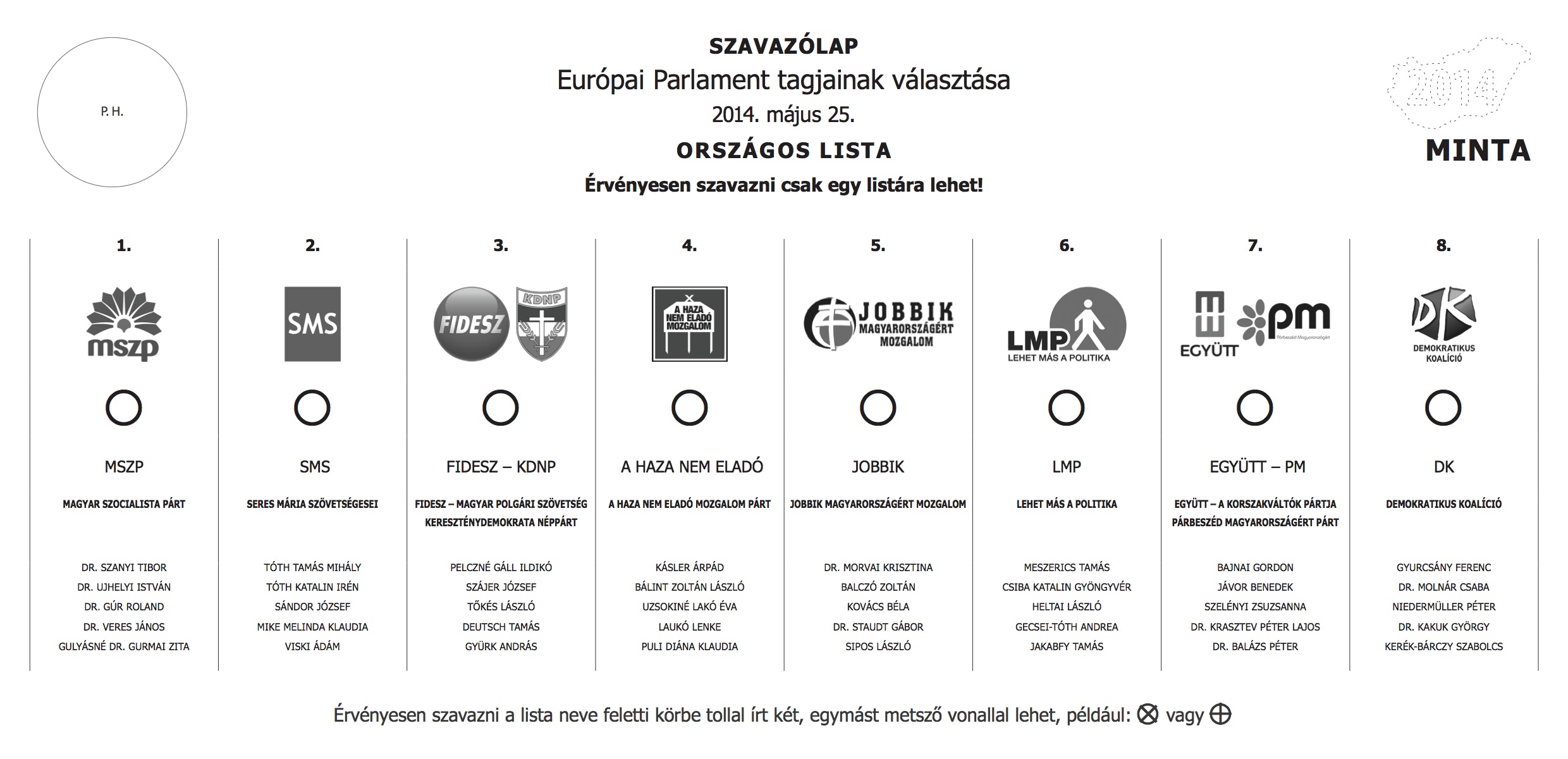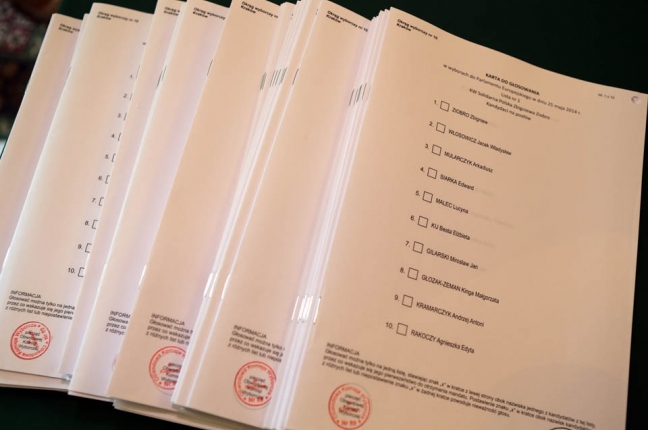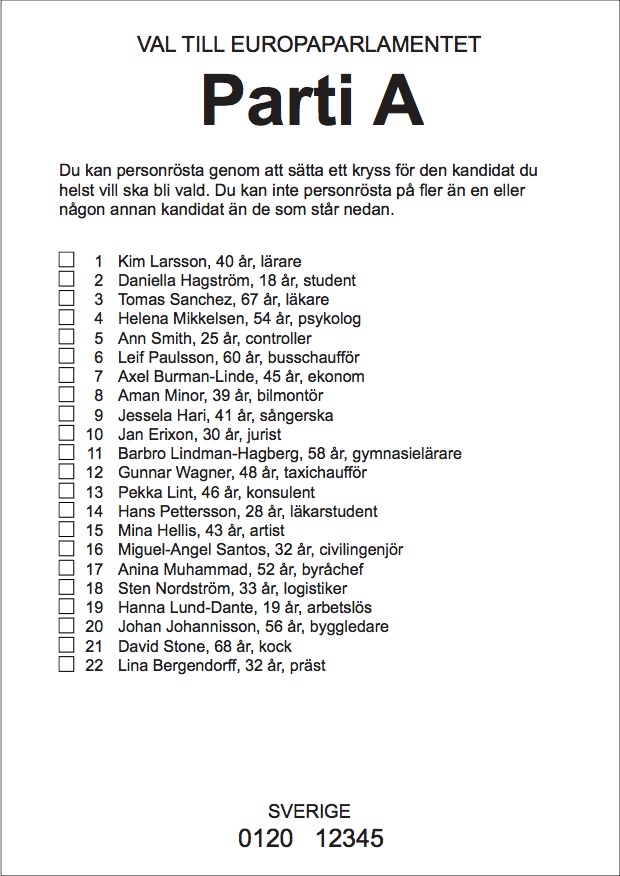The European elections 2014: Ballot structures and seat assignments
Austria Belgium Bulgaria Cyprus Czech Republic Germany
Denmark Estonia Hellenic Republic Spain Finland French Republic
Croatia
Hungary Ireland Italy Lithuania Luxembourg Latvia Malta
Netherlands Poland Portuguese Republic Romania Sweden Slovenia
Slovak Republic United Kingdom
In the European Parliament elections 2014 ballot structures vary across the 28 Member States. They differ widely ranging from voting for candidates only to parties only. In between, some ballots require the selection of one or more candidates, writing down the name or number the preferred candidate, crossing out those not preferred or just crossing a box, and others require the preferential ordering of a number of candidates. Furthermore ballot papers differ in that in some Member States a single ballot paper is distributed to the voters or one for each competing party.
AT Republic of Austria
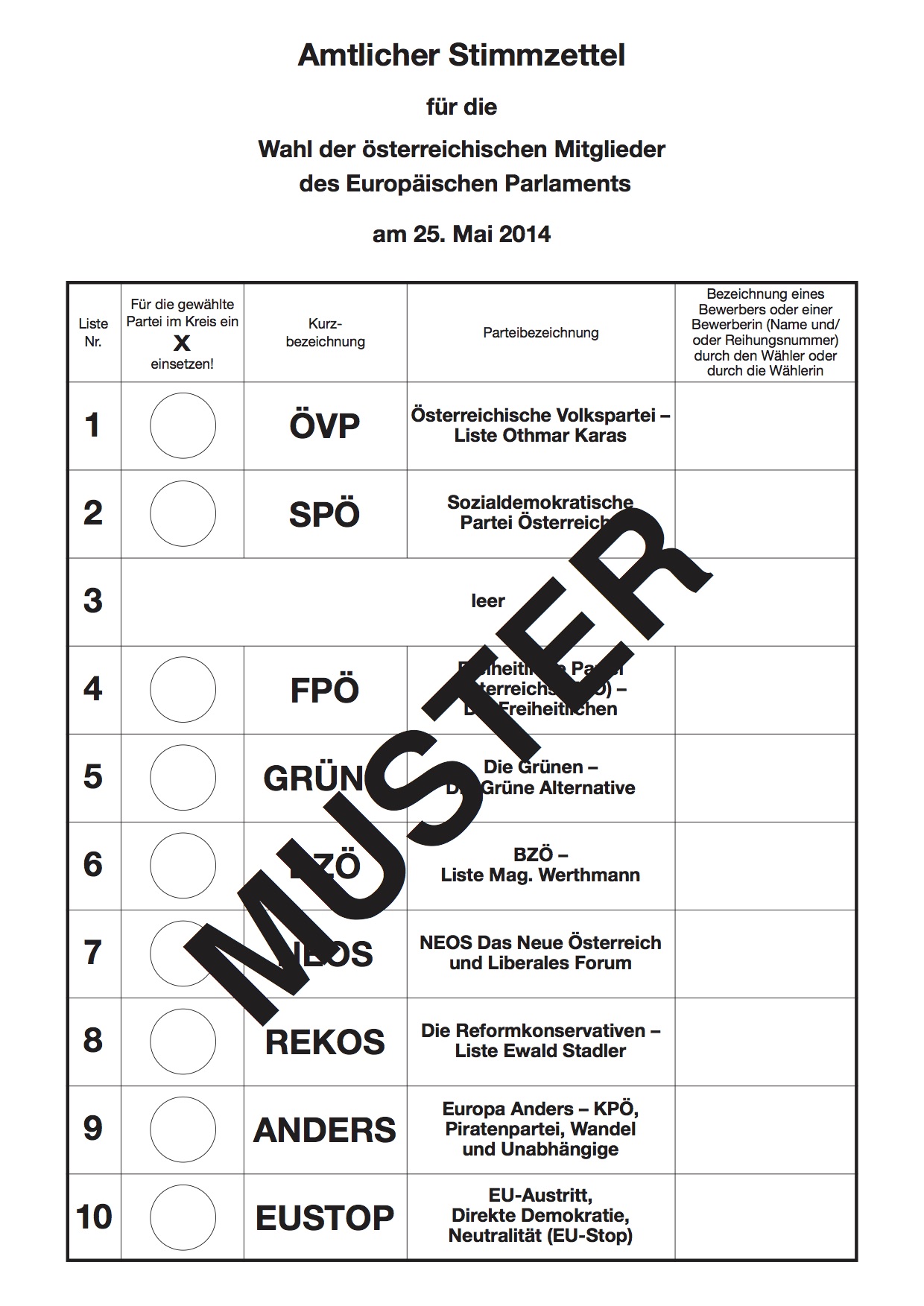 Single ballot
paper. Every voter has one vote. Additionally a voter may cast one
preferential vote for a candidate of the selected party. Therefore
he/she has to record either the candidate's last name or his/her
``ranknumber'' (Reihungsnummer).
Single ballot
paper. Every voter has one vote. Additionally a voter may cast one
preferential vote for a candidate of the selected party. Therefore
he/she has to record either the candidate's last name or his/her
``ranknumber'' (Reihungsnummer).
Candidates with at least 5% of preferential votes of their partie's candidates are considered first. It turns out that this treshold, although it was recently lowered from 7 to 5 percent, is too high in order that preferential votes have any influence in the filling of candidates.
(overview)
BE Kingdom of Belgium
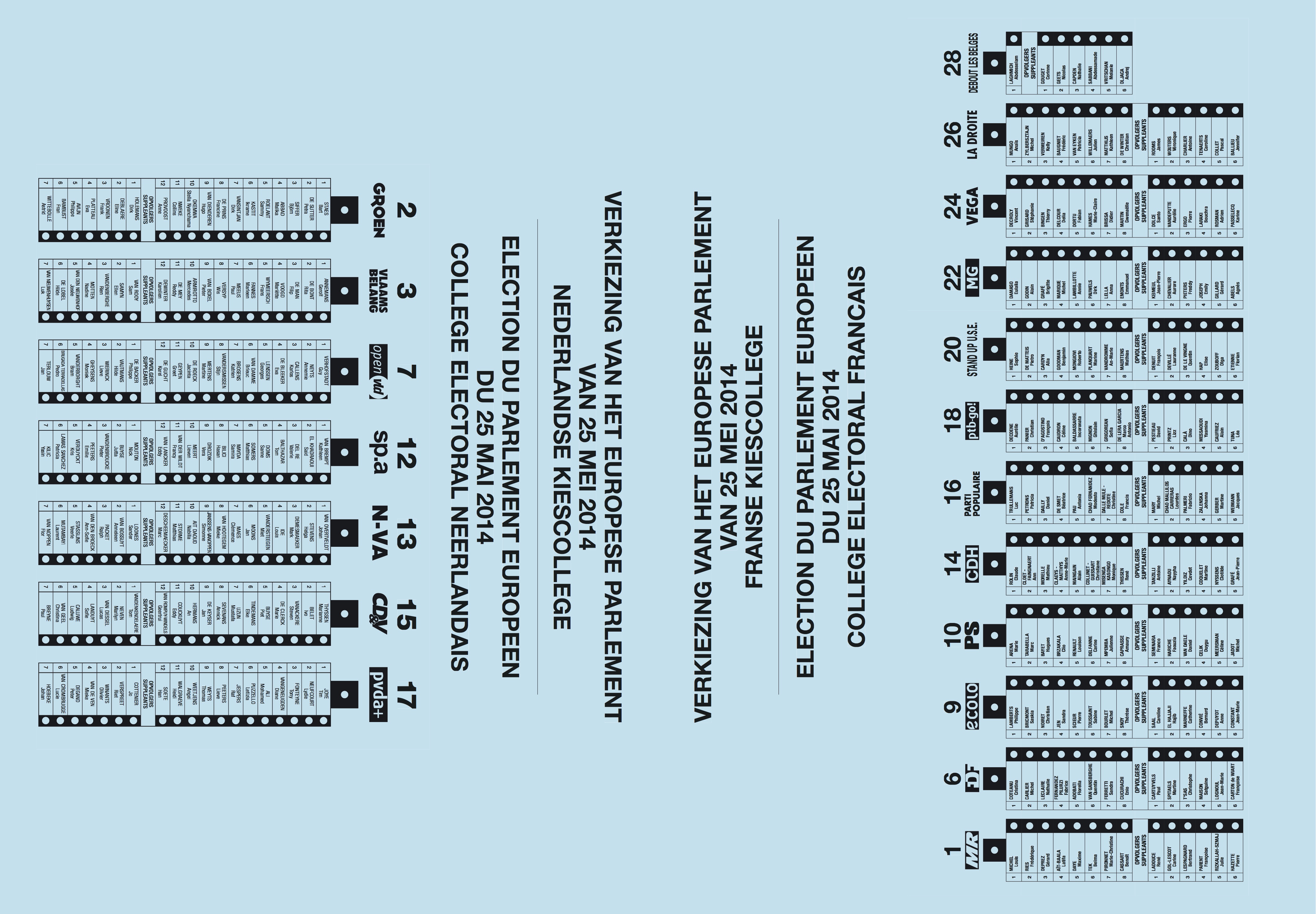 Ballot papers
vary across the four electoral constituencies (Brussels Capital
region, Walloon, Flemish, German-speaking). Every voter may either
cast one vote for a party list, or a party list and multiple
candidates of that list, or multiple candidates from one list. All
ballot papers {zip}.
Ballot papers
vary across the four electoral constituencies (Brussels Capital
region, Walloon, Flemish, German-speaking). Every voter may either
cast one vote for a party list, or a party list and multiple
candidates of that list, or multiple candidates from one list. All
ballot papers {zip}.
Ballot sheets that do not include at least one candidate vote provide benefit for the candidates listed first. The number of these ballot sheets is divided by two and is added to the top-ranked candidate's preferential votes. If his/her votes surpass the ``Wählbarkeitsziffer'', i.e. the number of total party votes divided by the number of total party seats plus 1, the surpluss is transferred to the candidate listed 2nd, etc.
Only within the Dutch electotal college's "Open Vld" preferential votes influence the filling of candidates. Karel De Gucht, former rapperteur on European Elections, is lifted from the list rank 12 to 3.
(overview)
BG Republic of Bulgaria
 Single ballot
paper. Every voter has one vote to give to a party or to an
independent candidate. In case the vote is given to a party, voters
may mark one out of maximal 17 candidates from that party.
Single ballot
paper. Every voter has one vote to give to a party or to an
independent candidate. In case the vote is given to a party, voters
may mark one out of maximal 17 candidates from that party.
Preferential votes cast for candidates are only taken into consideration in case the number of votes obtained by a candidate is at least 15% of valid preferential nvotes cast for the candidate list. Only BSP candidate ranked 15 is elected due to its preferential votes.
(overview)
CY Republic of Cyprus
 Single ballot
paper. Every voter has one vote to give to a party or to an
independent candidate. In case the elector decides to vote for a party
list he/she may additionally express his preference for a specific
candidate or candidates of the list of his choice. Crosses of
preference should not be more than two.
Single ballot
paper. Every voter has one vote to give to a party or to an
independent candidate. In case the elector decides to vote for a party
list he/she may additionally express his preference for a specific
candidate or candidates of the list of his choice. Crosses of
preference should not be more than two.
The votes received by the candidates determine who is elected.
(overview)
CZ Czech Republic
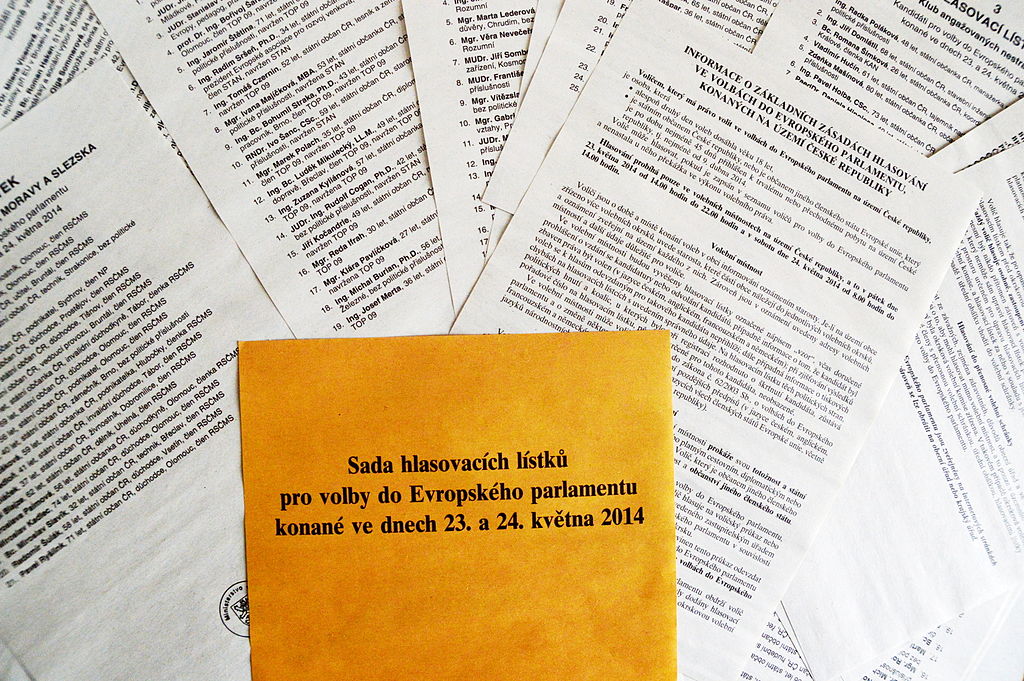 Each political
party, movement and coalition has its own ballot paper. Voters
receive an official envelope and all ballot tickets. The voter shall
place one ballot ticket into the official envelope. He/she may
indicate up to two preferred candidates. More ballot papers {pdf}.
Each political
party, movement and coalition has its own ballot paper. Voters
receive an official envelope and all ballot tickets. The voter shall
place one ballot ticket into the official envelope. He/she may
indicate up to two preferred candidates. More ballot papers {pdf}.
Preferential votes cast for candidates are taken into consideration only in case they amount at least to 5% of all preferential votes of the respective party. Only within the "Komunisticka str.Cech a Moravy" party the preferential votes have an effect, so that the candiate listed 4th is elected while the candidate listed 3rd is not.
(overview)
DE Federal Republic of Germany
 Ballot papers
vary across the 16 Bundesländer. Parties are allowed to register
nationwide candidate lists or lists for different Bundesländer. Only
the Christian Democratic parties (CDU/CSU) chose no to register
nationwide lists. Hence, the ballot papers differ only with respect to
the CDU/CSU regional lists. Every voter has one vote to give to a
party. A maximum of ten names of each party's candidates are printed
on the ballot sheet. The party decides on the ranking of the
candidates. More ballot papers {jpeg}.
Ballot papers
vary across the 16 Bundesländer. Parties are allowed to register
nationwide candidate lists or lists for different Bundesländer. Only
the Christian Democratic parties (CDU/CSU) chose no to register
nationwide lists. Hence, the ballot papers differ only with respect to
the CDU/CSU regional lists. Every voter has one vote to give to a
party. A maximum of ten names of each party's candidates are printed
on the ballot sheet. The party decides on the ranking of the
candidates. More ballot papers {jpeg}.
(overview)
DK Kingdom of Denmark
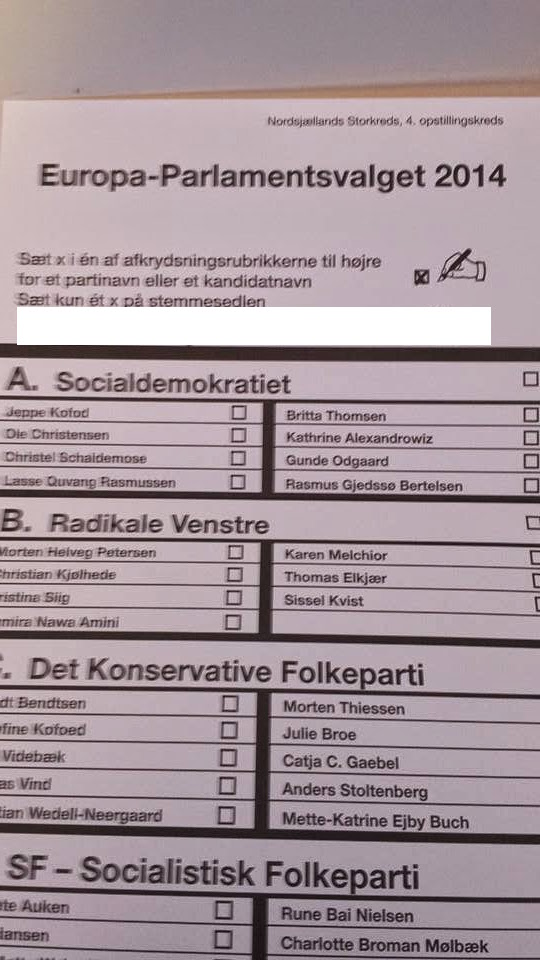 Single ballot
paper. Every voter may either cast one vote for a party or directly
for a candidate of the listed parties.
Single ballot
paper. Every voter may either cast one vote for a party or directly
for a candidate of the listed parties.
The votes received by the candidates determine who is elected.
(overview)
EE Republic of Estonia
EL Hellenic Republic
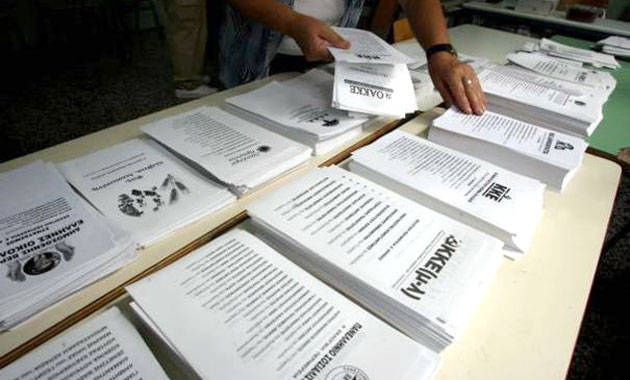 Every Party or
coalition has its own ballot paper. Voters choose one of them and can
express a preference for a maximum of four candidates of that list.
Every Party or
coalition has its own ballot paper. Voters choose one of them and can
express a preference for a maximum of four candidates of that list.
(overview)
ES Kingdom of Spain
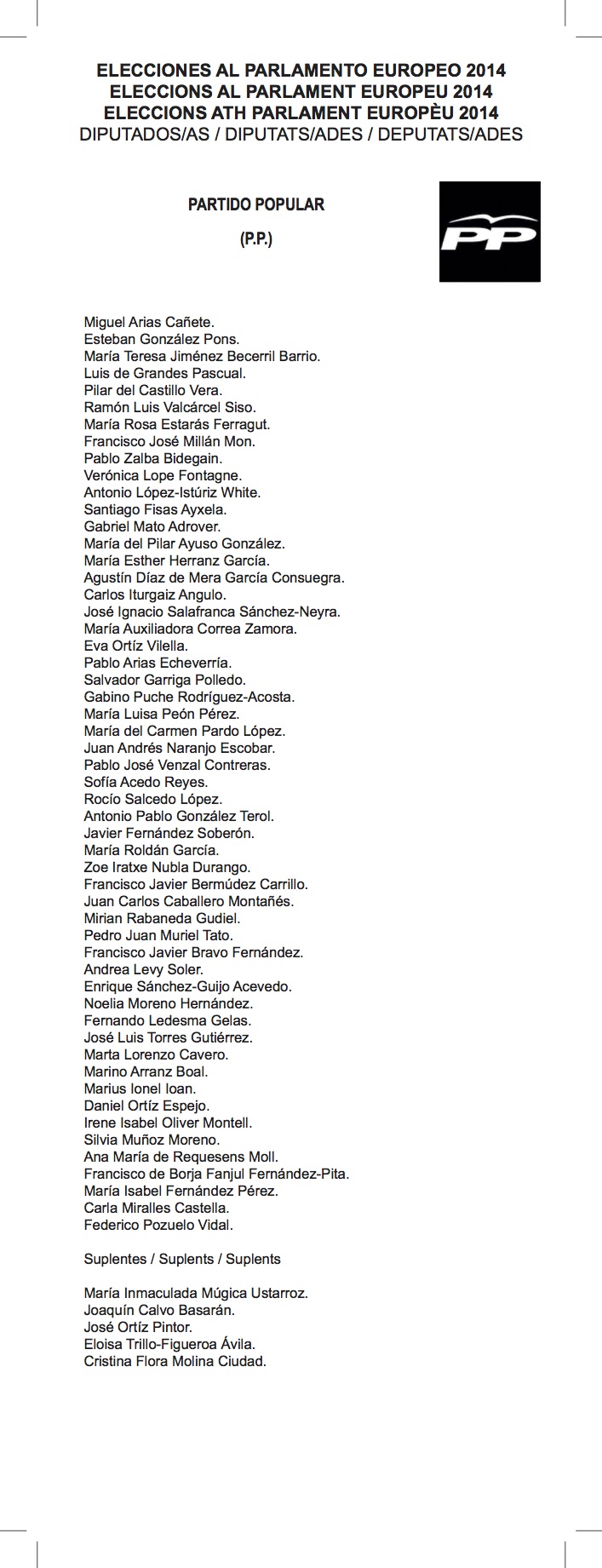 Every party or
coalition has its own ballot paper. A voter chooses the ballot paper
of his/her preferred party and puts it into an apposite
envelope. There are slight differences in the ballot papers
across the various language regions. All ballot papers {zip}.
Every party or
coalition has its own ballot paper. A voter chooses the ballot paper
of his/her preferred party and puts it into an apposite
envelope. There are slight differences in the ballot papers
across the various language regions. All ballot papers {zip}.
The parties decide on the ranking of their candidates.
(overview)
FI Republic of Finland
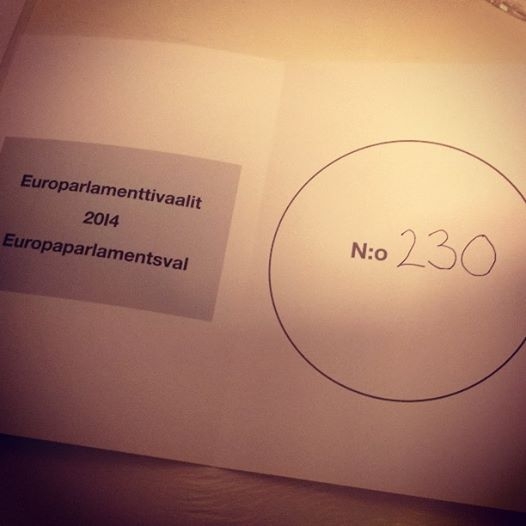 Single ballot
paper. Voters cast a single vote for their preferred candidate
directly by putting the corresponding number on the ballot paper.
Single ballot
paper. Voters cast a single vote for their preferred candidate
directly by putting the corresponding number on the ballot paper.
The votes received by the candidates determine who is elected.
(overview)
HR Republic of Croatia
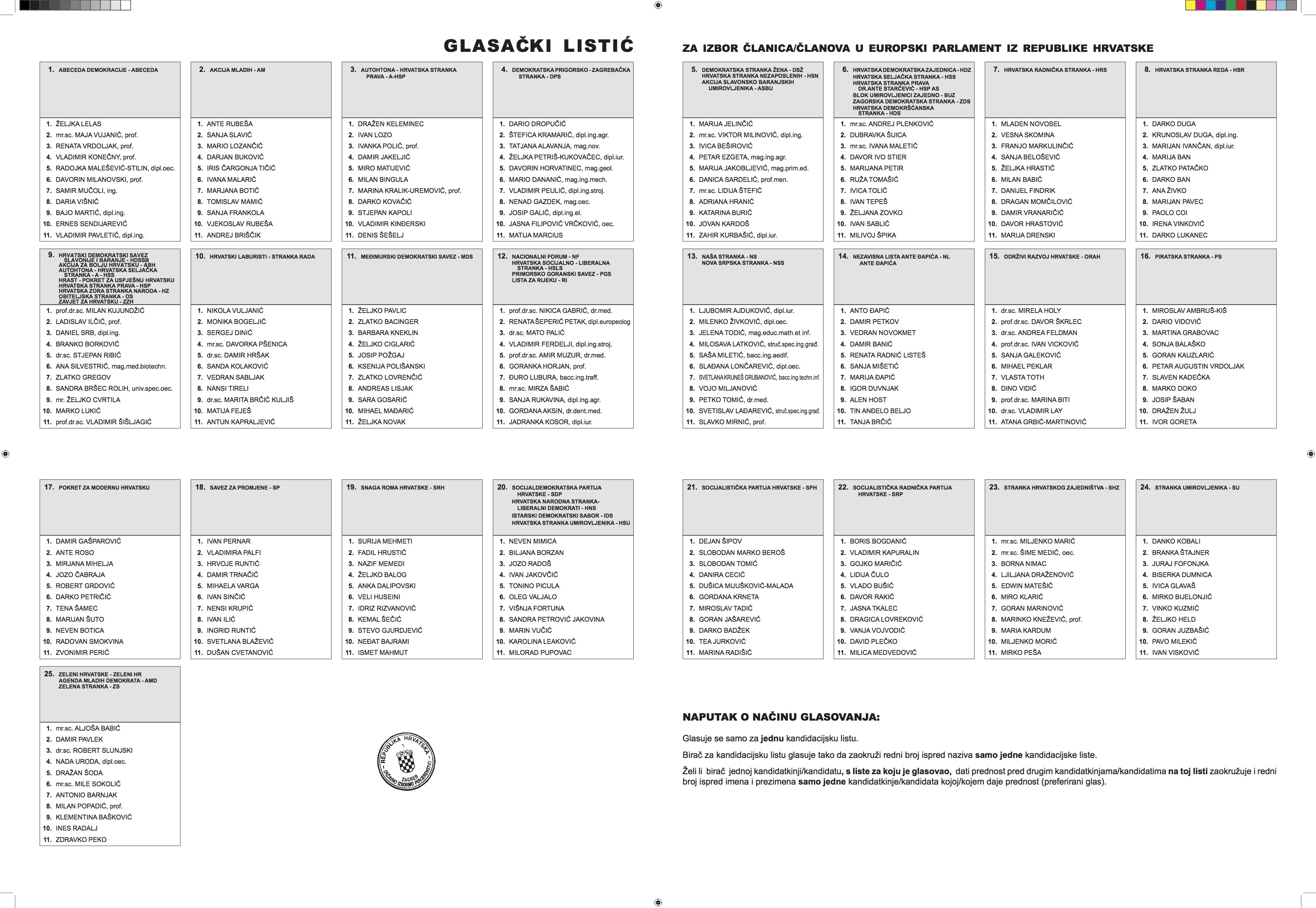 Single ballot
paper. Voters vote for a single candidate slate. Voters may
designate one single candidate.
Single ballot
paper. Voters vote for a single candidate slate. Voters may
designate one single candidate.
Preferential votes cast for candidates are only taken into consideration in case the number of votes obtained by a candidate is at least 10% of valid preferential nvotes cast for the candidate list. Only one is elected due to its preferential votes.
(overview)
IE Ireland
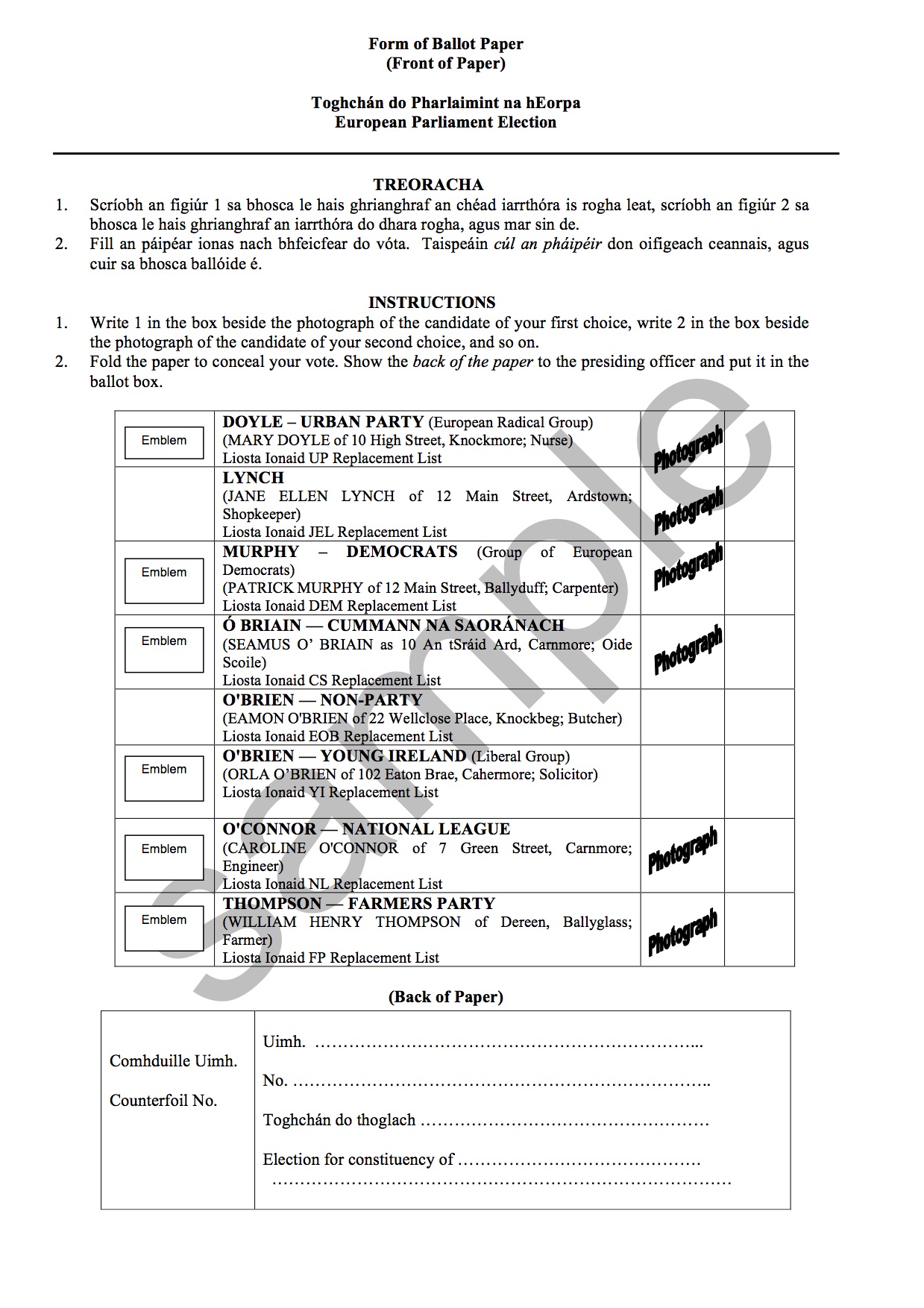 The names of the
candidates appear in alphabetical order on the ballot paper, together
with their photograph, political affiliation and party emblem, if
any. The voter indicates the order of their choice by writing 1
opposite the name of their first choice, 2 opposite the name of their
second choice, 3 opposite the name of their third choice and so on.
More ballot papers {jpeg}.
The names of the
candidates appear in alphabetical order on the ballot paper, together
with their photograph, political affiliation and party emblem, if
any. The voter indicates the order of their choice by writing 1
opposite the name of their first choice, 2 opposite the name of their
second choice, 3 opposite the name of their third choice and so on.
More ballot papers {jpeg}.
(overview)
IT Republic of Italy
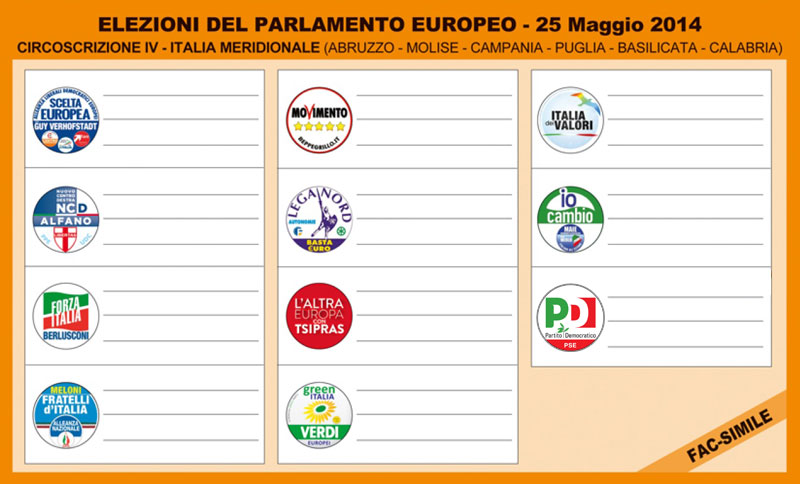 The ballot paper's color varies across the five electoral constituencies
(North-west: gray, North-east: brown, center: red, Meridional: orange,
Insular: pink). Voters stamp next to their party's
symbol. Additionally they have up to three preferential votes by
putting the candidate's name next to party symbol. In case of three
preferences at least one has to be male and one female. If there is no
gender diversity in the voter’s preferences, the second and third
preferences will be deemed null and void. More ballot papers {zip}.
The ballot paper's color varies across the five electoral constituencies
(North-west: gray, North-east: brown, center: red, Meridional: orange,
Insular: pink). Voters stamp next to their party's
symbol. Additionally they have up to three preferential votes by
putting the candidate's name next to party symbol. In case of three
preferences at least one has to be male and one female. If there is no
gender diversity in the voter’s preferences, the second and third
preferences will be deemed null and void. More ballot papers {zip}.
(overview)
LT Republic of Lithuania
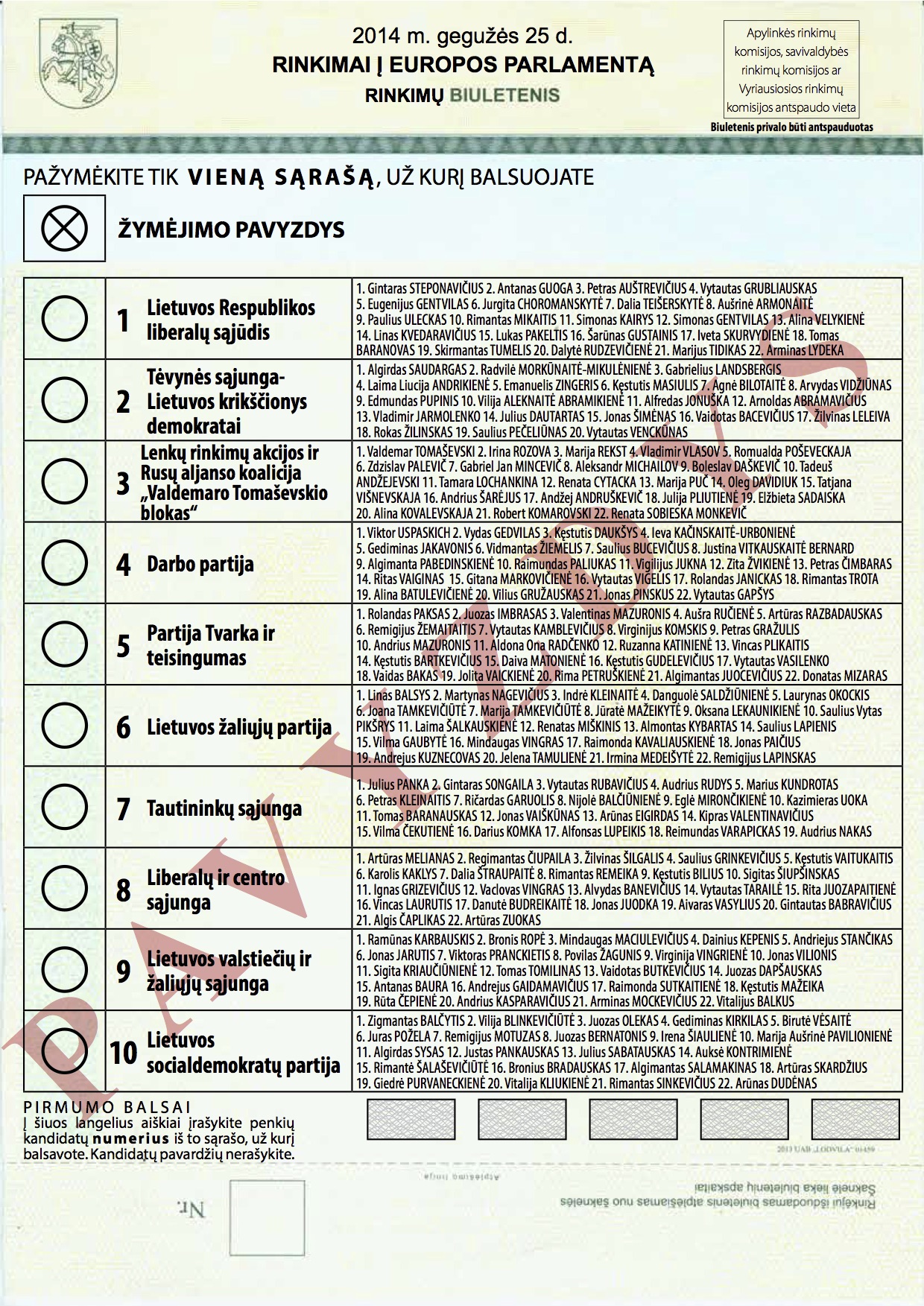 Single ballot
paper. Every voter has one party vote. Additionally he/she may give up
to five preferential votes by putting the respective numbers in the
squares at the ballot's bottom line.
Single ballot
paper. Every voter has one party vote. Additionally he/she may give up
to five preferential votes by putting the respective numbers in the
squares at the ballot's bottom line.
(overview)
LU Grand Duchy of Luxembourg
 Every voter has
six votes. He/she can freely distribute these votes to candidates of
various lists with a maximum of two votes per candidate. Alternatively
the voter may vote for a single party.
Every voter has
six votes. He/she can freely distribute these votes to candidates of
various lists with a maximum of two votes per candidate. Alternatively
the voter may vote for a single party.
Votes are counted by lists, and candidates are elected according to their number of preferential votes.
(overview)
LV Republic of Latvia
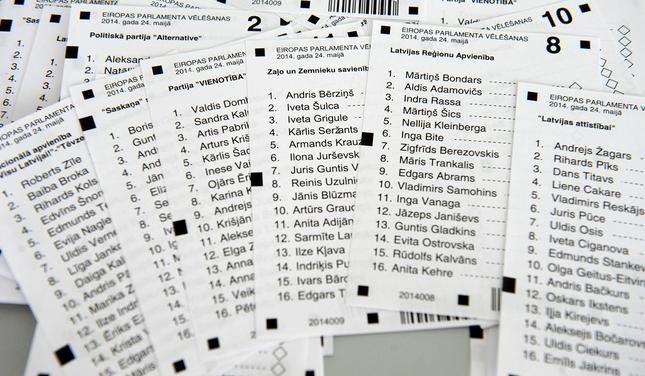 Every party or
coalition has its own ballot paper. Voters vote for one
party. Preferential votes and penalizing votes can be given to any of
the list's candidates. Within a list candidates are elected according
to their personal votes.
Every party or
coalition has its own ballot paper. Voters vote for one
party. Preferential votes and penalizing votes can be given to any of
the list's candidates. Within a list candidates are elected according
to their personal votes.
(overview)
MT Republic of Malta
NL Kingdom of the Netherlands
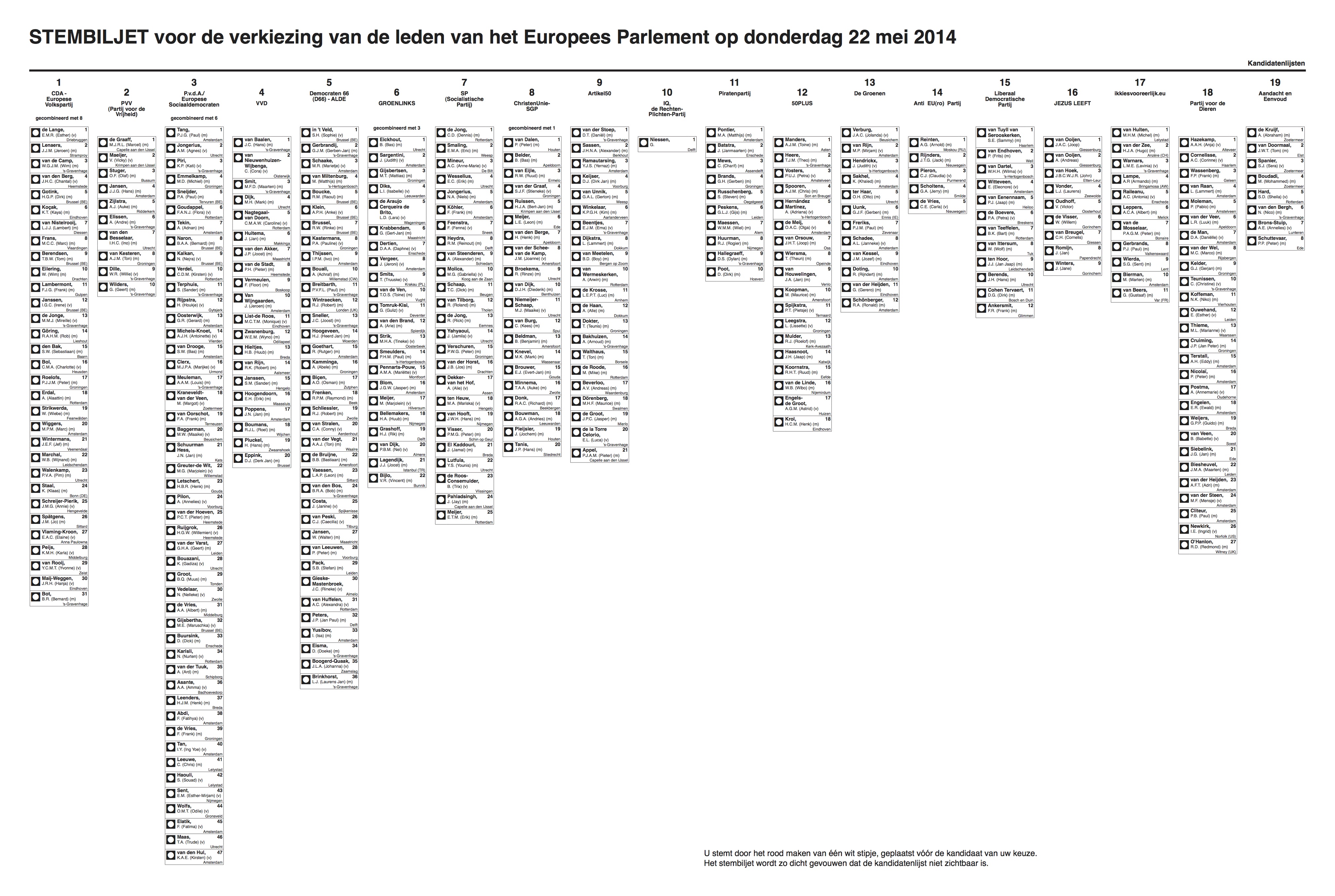 Single ballot
paper. A single vote can be given to one of the candidates of the
voter's preferred party.
Single ballot
paper. A single vote can be given to one of the candidates of the
voter's preferred party.
(overview)
PL Republic of Poland
PT Portuguese Republic
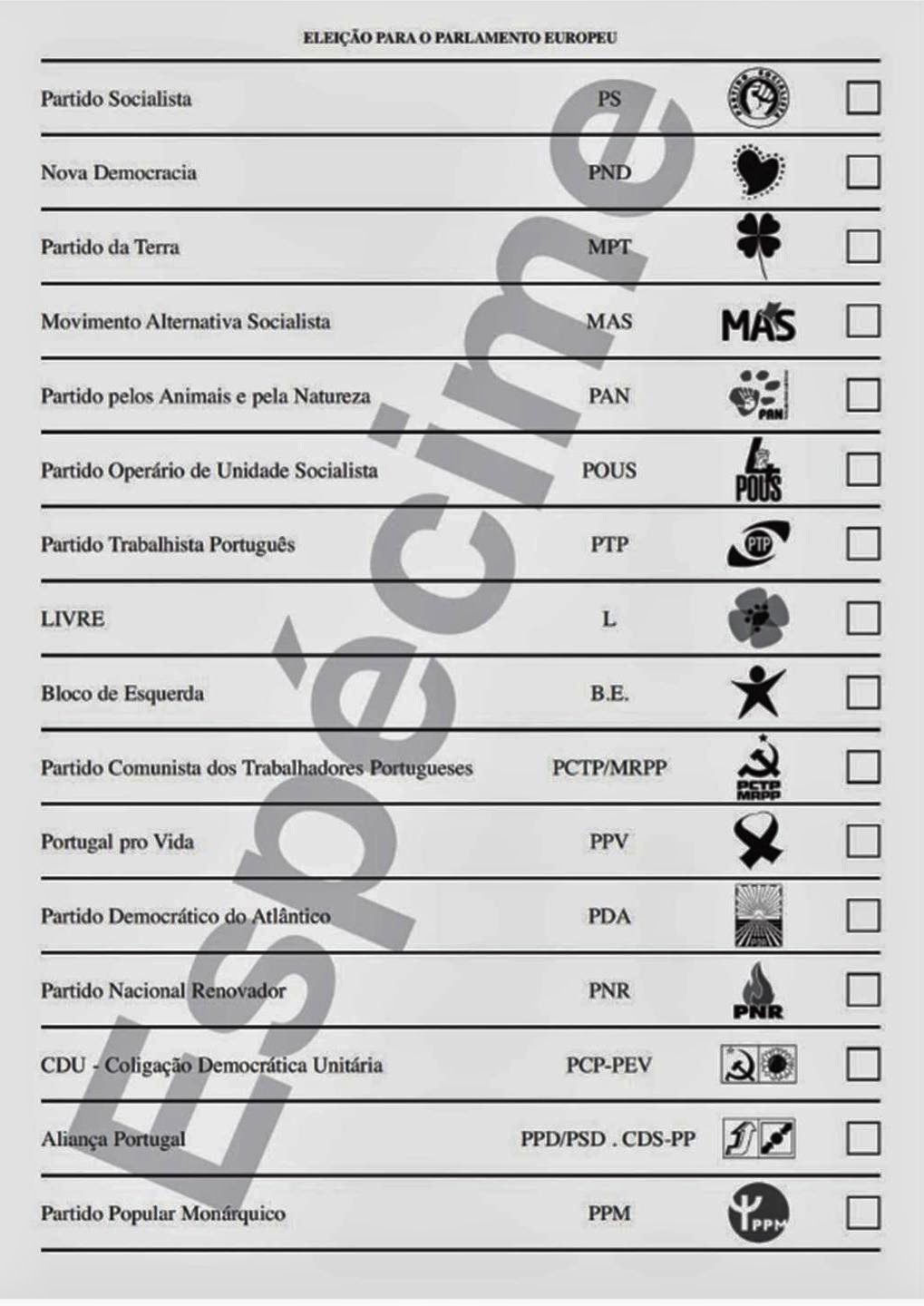 Single ballot
paper. Every voter has a single party vote. The names of the parties'
candidates are not printed on the ballot sheet. The party decides on
the ranking of the candidates.
Single ballot
paper. Every voter has a single party vote. The names of the parties'
candidates are not printed on the ballot sheet. The party decides on
the ranking of the candidates.
(overview)
RO Romania
SE Kingdom of Sweden
SI Republic of Slovenia
 Single ballot
paper. Every voter has one party vote. In order to express his/her
opinion one has to circle the party’s number. Facultatively one
preferential vote can be given. For postal voting a voter enters the
name of his/her preferred party in the right-hand box. Additionally
the voter may enter the name of his/her preferred candidate from the
chosen party in the left-hand box. Postal voting ballot {pdf}.
Single ballot
paper. Every voter has one party vote. In order to express his/her
opinion one has to circle the party’s number. Facultatively one
preferential vote can be given. For postal voting a voter enters the
name of his/her preferred party in the right-hand box. Additionally
the voter may enter the name of his/her preferred candidate from the
chosen party in the left-hand box. Postal voting ballot {pdf}.
Preference votes are taken into account only if the number of preference votes for an individual candidate exceeds the quotient calculated by dividing the total number of votes cast for the list by double the number of candidates on the list. Two out of 8 candidates were elected due to their preferential votes.
(overview)
UK United Kingdom
 Voters have a single party vote.
Voters have a single party vote.
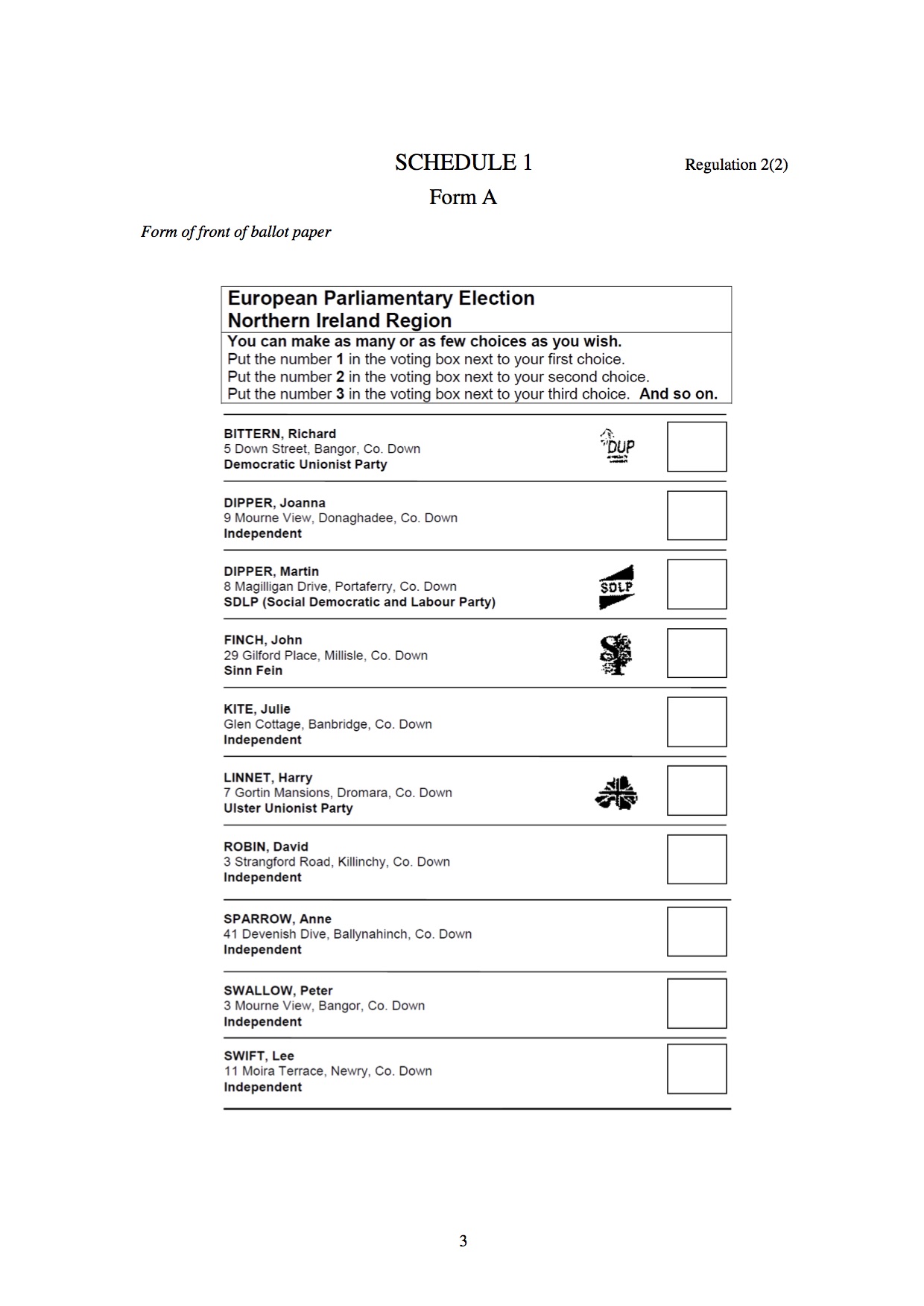 In
Northern-Ireland voters are asked to give a preference ranking to as
many candidates on the ballot as they wish. Voters may choose
candidates from different political parties.
In
Northern-Ireland voters are asked to give a preference ranking to as
many candidates on the ballot as they wish. Voters may choose
candidates from different political parties.


